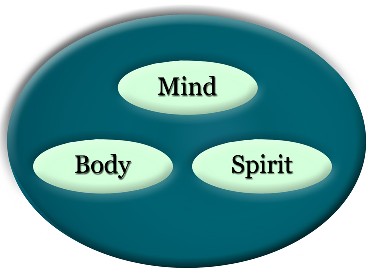
Citation: Huitt, W. (2018). A systems approach to the study of human behavior (revised). Educational Psychology Interactive. Valdosta State University. http://www.edpsycinteractive.org/materials/sysmdlo.html
| EdPsyc Interactive: Courses | Home Page |
A worldview, conceptual framework, or model is a critical component of one's vision of the possibilities for human learning and development as it defines the important variables to consider and the relationships among those variables. There are a number of different philosophical positions that provide a foundation for organization and interpretation of empirical data into models. One of those positions is that the universe and everything in it is comprised of physical, material components. It operates in a deterministic manner (much like a machine) and components can be reduced to a simple entity. If one wants to know about multiple entities, these can be studied one at a time and the acquired knowledge can then be aggregated for an understanding of the whole. This is the foundation of Newtonian physics and the position that forms the foundation for much of the research in science, including psychology. An implication of this belief is that the interaction of domains such as cognition and emotion can be studied by adding and subtracting explicit, measurable variables in multiple variations. For example, if one wants to study the relationship of critical thinking and emotional development, each can be investigated separately and then studied together by first introducing one factor, then removing it, and introducing another factor. If one wants to study what makes for an effective school, the researcher can introduce factors one at a time to see which one has the greatest impact.
A competing position is that one must not only understand the entities in isolation, but must understand the relationships between or among entities. In this view, it is not enough to first study the development of thinking and then the development of emotion or to identify separate factors that make an effective school, rather these must be studied together in order to understand the relationships among the factors. This systems or organismic view reflects a transactional approach to educational and developmental psychology (e.g., Gordon, 1975; Schiamberg & Smith, 1982; Thompson, 1971) and provides the basis for the framework for studying human behavior presented below. Additionally, Koestler (1990) proposed that each individual component is a holon (simultaneously both a part and a whole) arranged in a holarchy (a never-ending relationship of parts to whole).
This systems/organismic/holarichical approach is reflected in this framework in several ways. First, the basis of the framework stems from an acceptance of the three major aspects of human beings (Mind, Body and Spirit) that have been the focus of the study since the ancient Greeks. These relationships would be represented as a whole (the person) with three component parts (body, mind, spirit).

In terms of mind (a whole, sometimes called the human personality), there is wide support for three dimensions or domains (e.g., Eysenck, 1947; Miller, 1991; Norman, 1980): 1) cognition (knowing, understanding, thinking); 2) affect (feelings, emotions, attitudes, predispositions); and 3) conation (volition, will, intentions to act, reasons for taking action). The three components of the mind can be used to organize many of the major issues and topics discussed in educational psychology. This framework recognizes that the mind receives information and manifests action through the body. Body can be considered in terms of 1) biological or genetic influences; 2) bodily functioning, and 3) overt behavior as extensively studied by behaviorists (Graham, 2002). The framework also recognizes that there is a feedback loop between overt responses (or "behavior") and resulting stimuli from the environment. Finally, the framework recognizes both biological and spiritual influences on the development and functioning of the components of mind.
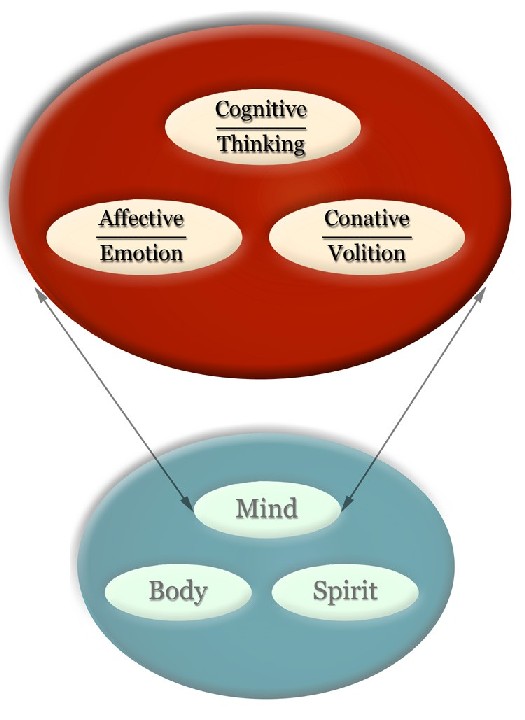
There are therefore five major components of the individual in this systems approach to the study of human behavior:
- Cognitive component -- Perceives, stores, processes, and retrieves information
- Affective component -- Can modify perceptions and thoughts before and after they are processed cognitively
- Conative component -- Directs and manages input and output functioning
- Spiritual component -- How human beings relate to themselves, to others, and approach the unknowns of life, how human beings define and relate to the sacred
- Behavioral system -- Overt action of organism (output of the individual)
It is hypothesized that an individual's thinking (cognition), feeling (affect), and willing (volition, conation) as well as overt behavior and spirituality develop as a result of:
- transactions among the various components of mind as
- influenced by biological maturation, bodily functioning, and the spiritual dimension of the individual,
- the environment or context of the individual, and
- the reflection on feedback from the environment as a result of an individual's overt behavior.
This is quite similar to a social-cognitive view as developed by Bandura (1986).
A related aspect of the framework is that human beings do not develop in isolation; they develop in a variety of contexts (environments in which the individual human being is in constant interaction) that have a major role in human development and behavior (e.g., Bridge, Judd & Moock, 1979; Bronfenbrenner, 1977, 1979, 1989; Koestler, 1990)
The first level of the ecology or the context of human development (Bronfenbrenner, 1977, 1979, 1989) is the microsystem (the individual is now considered as a holon in a holarchical relationship to the family). This level has the most immediate and earliest influence and includes the family,
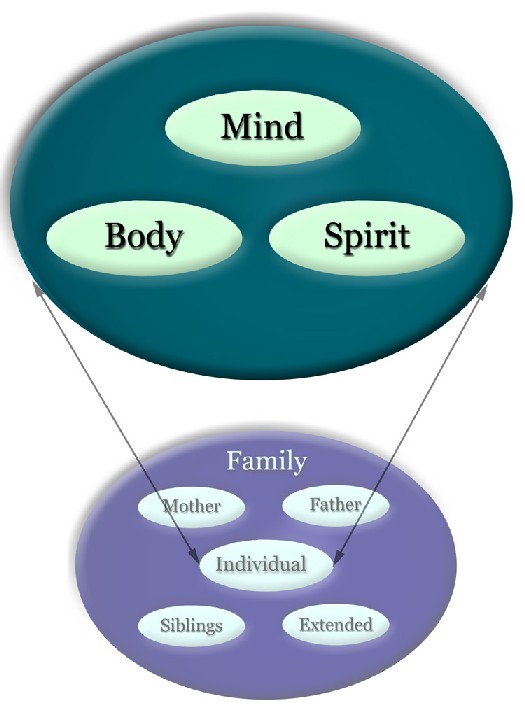
along with local neighborhood or community institutions such as the school, religious institutions and peer groups as well as the specific culture within which the family identifies.
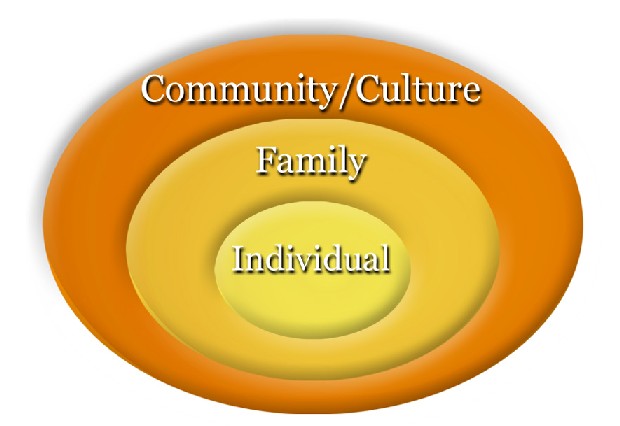
The second level is the mesosystem. This has an intermediate level of influences and includes social institutions involved in such activities as transportation, entertainment, news organizations, and the like. The influence of these systems and institutions interacts with, and is filtered through, the microsystem institutions.
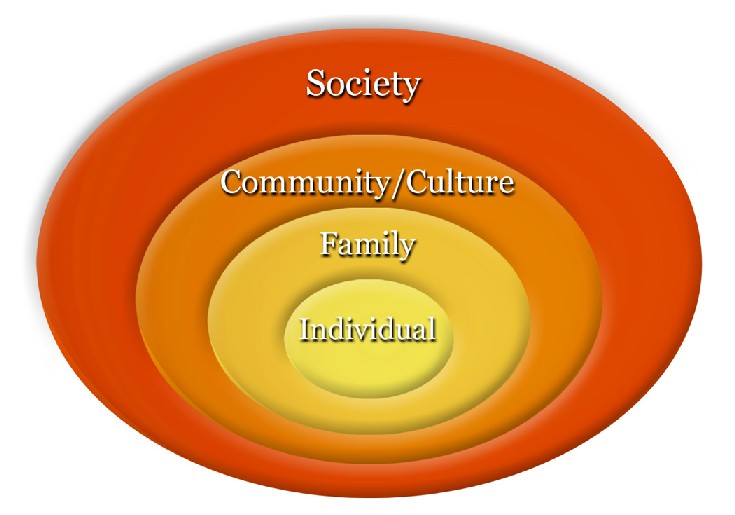
The third level is the macrosystem. This is comprised of the most removed influences such as international region or global changes or even more abstract aspects of culture. For example, the movement from the agriculture and industrial economies to a digital, information/conceptual age is having widespread influence on the ways societies, communities, and families are operating.

Another way to think about the systems model as it applies to human beings is to consider the individual person as embedded first in the family then in the school and a circle of friends, and then in work or career. These are all embedded in one or more neighborhoods and a community which is, in turn embedded in a region. These are, in turn, embedded in an international region and the world. The earth and solar system are part of the cosmos. This conceptualization highlights the multiple relationships an individual has and the need to consider the specific relationships that might be important for a specific individual. What is common to all people, at least at this point in time, is that all are part of the cosmos and living on planet earth. This certainly has implications for issues of human development and education as discussed on this website (Huitt, 2012a, 2012b, 2018a, 2018b).
The level of international regions introduces important variety that can be considered in a number of ways. For example, the World Trade Organization (2010) considers seven international regions: (1) North America, (2) Central and South American and the Caribbean, (3) Europe, (4) Commonwealth of Independent States, (5) Africa, (6) Middle East, and (7) Asia. However, the United Nations makes further delineations. For example, Africa would be considered as encompassing five international regions: (1) Eastern Africa, (2) Middle Africa, (3) Northern Africa, (4) Southern Africa, and (5) Western Africa (United Nations Statistics Division, 2012). Of course, there are then nations, and states within nations, as well as multistate regions within nations that could be considered.
The critical point in this analysis is that while there is a tendency to focus on family or school influences on human development, it should be remembered that there are other important influences. An African, as well as Native American, tradition states that it takes a whole community to raise a child. From the perspective advocated here, the entire globe can be considered a community and thinking both locally and globally is an essential requirement for educating children and youth today. This is an important principle of a complex adaptive systems approach in that there are competing factors, both within the individual and the context within which the individual exists, as well as the interaction between individual and context that influence learning and development. Creating a homeodynamic balance among these competing factors is a key factor in the effective and efficient functioning of such a system.
More importantly there is a reciprocal, dynamic process involved in creating that balance. While the context certainly influences the development of individual competencies, the individual also influences the context within which one is living. Developing competencies that are then used in the service of others contributes to an ever-advancing civilization, be it at the local, national, or global level. This then creates a more positive environment within which human capacities can be developed.
An important aspect of this framework is that it reflects an approach that defines human beings as having both biological and spiritual components of their nature (e.g., Danesh, 1994; Frankl, 1946/1984). From the perspective of philosophy, this is called a dualist position (Robinson, 2007). That is, it is assumed that the biological brain and the psychological mind are two separate entities and should be studied transactionally. It is also postulated that human beings have a soul or spirit that influences the operation of the mind and that continues to exist after the decomposition of the body. The opposite of this position, the materialistic viewpoint, states that there is no non-materialistic aspect to the universe and to human beings and that the mind is totally a result of brain functioning. From this perspective the mind ceases to function when the brain ceases to function.
One of the implications of the dualist position is that there are many sources of knowledge about human beings and human nature that must be considered. That is, if human beings are more than what the materialists believe, then science, which is limited in its study to the material universe, cannot inform us totally about human beings and human behavior. If a more complete understanding is to be developed, additional sources of information must be considered. While the vast majority of the materials on this website focus on understandings derived within the parameters of a scientific approach as the standard for developing understanding and discerning truth, I acknowledge that other sources of knowledge (e.g., personal experience and intuition, spiritual and religious scriptures and background, and study of philosophy) have also influenced the development of this framework and my interpretation of data. I will make my viewpoint about human beings as explicit as possible so that you can accurately judge to what extent my philosophical position may suggest a particular interpretation when another is equally valid.
Throughout your reading of material on this website, there will likely be instances where the research findings do not match knowledge or viewpoints you have already acquired. It is also possible that you have a different viewpoint or philosophy that would allow a different interpretation of data than the one I provide. Should this occur, please view this dissonance as an opportunity to develop new understandings or to integrate previous understandings in new ways. It is not always necessary to completely discard knowledge derived from either science or other sources, but interpretations may need to be modified in order to include the findings derived from science. I encourage others to develop their own frameworks that might highlight other aspects of human learning and development not adequately attended to in this approach.
References
| Internet Resources | Electronic Files |
Return to: